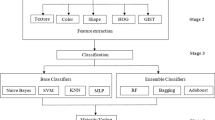Abstract
In order to improve the forecasting accuracy of the occurrence period of insect pests, this paper proposes a kind of forecasting method based on the combination of rough set theory and improved PSO-BP neural network. It takes insect pests of Euphrates poplar forests as the object of study. First, an attribute reduction algorithm of rough set is used to eliminate redundancy attributes. Input factors of the forecasting model of insect pests (temperature, humidity and rainfall) can be reduced from sixteen to eight. Then, particle swarm optimization (PSO) algorithm is improved using the inertia weight, and weights and thresholds of BP neural network are optimized using the improved PSO algorithm. Finally, the forecasting model of insect pests is established using rough set and an improved PSO-BP network. The test results show that rough set theory can effectively reduce the feature dimension and the improved PSO algorithm can reduce the iteration times, with an average accuracy of 94.8 %. This method can provide the technical support for the prevention and control of the insect pests of the Euphrates poplar forests.




Similar content being viewed by others
References
Zhang F-L, Jing T-Z, Wang Z-Y, Xie S-P, Zhang H (2011) Path analysis of meteorological factors and dendrolimus superans population density. Hubei Agric Sci 50(19):3977–3979
Wang N-H, Zhang Y-R (2009) Design and realization of expert system for diseases and insect pests in rapid-growing and high-yield forests in northeastern China. J Beijing For Univ 31(S2):27–30
Ma X-Y, Song Z-W, Wang J-C, Lv X-J (2010) Analysis on the application of expert system for diseases and insect pests forecasting in facility agriculture in Tianjin. Tianjin Agric Sci 16(4):117–119
Damianos G, George E-T, Christos A (2009) A mobile agent platform for distributed network and systems management. J Syst Softw 82(2):355–371
Michael C, Wimberly, Zhang Y-J (2006) Computer Applications in Sustainable Forest Management. Springer, Netherlands vol 11, pp 201–222
M-S WEI, G-Y LI (2007) FNN-based intelligent insect pest forecast for crops. J Taiyuan Univ Sci Technol 28(6):442–445
Bai B, Chen S-J, Geng Q-H (2008) Study on the relationship between the space distribution and habitat spring inchworm happened in Tarim river basin. Acta Agric Jiangxi 20(5):56–58
Chen D-G, Zhao S-Y (2010) Local reduction of decision system with fuzzy rough sets. Fuzzy Sets Syst 161(13):1871–1883
Liang J-Y, Li R, Qian Y-H (2012) Distance: a more comprehensible perspective for measures in rough set theory. Knowl-Based Syst 27:126–136. doi:10.1016/j.knosys.2011.11.003
Pawlak Z, Skowron A (2007) Rudiments of rough sets. Inf Sci 177(1):3–27
Yao Y-Y, Zhao Y (2008) Attribute reduction in decision theoretic rough set models. Inf Sci 178(17):3356–3373
Hu Q-H, An S, Yu D-R (2010) Soft fuzzy rough sets for robust feature evaluation and selection. Inf Sci 180(22):4384–4400
Wang X-Z, Tsang E-C-C, Zhao S-Y, Chen D-G, Yeung D-S (2007) Learning fuzzy rules from fuzzy samples based on rough set technique. Inf Sci 177(20):4493–4514
Bipul L, Venayagamoorthy GK (2010) Particle swarm optimization with quantum infusion for system identification. Eng Appl Artif Intell 23(5):635–649
Shourian M, Mousavi S-J, Tahershamsi A (2008) Basin-wide water resources planning by integrating PSO algorithm and MODSIM. Water Resour Manage 22(10):1347–1366. doi:10.1007/s11269-007-9229-1
Taylan M, Das L, Dulger C (2009) Signature verification (SV) toolbox: application of PSO-NN. Eng Appl Artif Intell 22(4–5):688–694. doi:10.1016/j.engappai.2009.02.005
Tsai K-H, Wang T-I, Hsieh T-C, Chiu T-K, Lee M-C (2010) Dynamic computerized testlet-based test generation system by discrete PSO with partial course ontology. Exp Syst Appl 37(1):774–786. doi:10.1016/j.eswa.2009.05.090
Ciurana J, Arias G, Ozel T (2009) Neural network modeling and particle swarm optimization (PSO) of process parameters in pulsed laser micromachining of hardened AISI H13 steel. Mater Manuf Process 24(3):358–368. doi:10.1080/10426910802679568
Ling S-H, Iu H–H-C, Leung F-H-F (2008) Improved hybrid particle swarm optimized wavelet neural network for modeling the development of fluid dispensing for electronic packaging. IEEE Trans Ind Electron 55(9):3447–3460. doi:10.1109/TIE.2008.922599
Yu J-B, Wang S-J, Xi L-F (2008) Evolving artificial neural networks using an improved PSO and DPSO. Neurocomputing 71(4–6):1054–1060. doi:10.1016/j.neucom.2007.10.013
He L-H, Liu J-G, Wen Y-X (2009) Nondestructive testing of eggshell based on rough sets and support vector machine. Trans Chinese Soc Agric Mach 40(3):167–171
Wang G, Zhang Z-Y (2006) A study of data fusion based on combining rough set with BP neural network. J Xi’an Univ Technol 22(3):311–314
Liu Y, Weisberg R-H, Mooers C-N-K (2006) Performance evaluation of the self-organizing map for feature extraction. J Geophys Res Oceans 111:C05018. doi:10.1029/2005JC003117
Acknowledgments
This work is supported by the National Natural Science Foundation of China (Grant No. 61362026) and the principal fund of Tarim University of China (No. TDZKSS201207). I also wish to thank every group members for their many helpful suggestions and work.
Author information
Authors and Affiliations
Corresponding author
Rights and permissions
About this article
Cite this article
Bai, T., Meng, H. & Yao, J. A forecasting method of forest pests based on the rough set and PSO-BP neural network. Neural Comput & Applic 25, 1699–1707 (2014). https://doi.org/10.1007/s00521-014-1658-1
Received:
Accepted:
Published:
Issue Date:
DOI: https://doi.org/10.1007/s00521-014-1658-1




